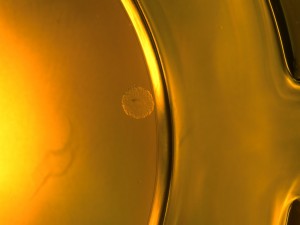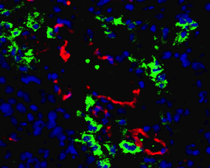
Cancer stem cells’ clever defenses may be the seeds of their undoing. (Image: leftover bacon/OpenClipArt)
Some scientists still debate the existence of cancer stem cells – rare cells that can singlehandedly perpetuate a tumor, and possibly make it more aggressive. But others have moved on, isolating candidate cancer stem cells and documenting their distinctive characteristics and markers.
And some are starting to figure out how these cells operate and leverage that knowledge to come up with new approaches to cancer therapy.
Children’s scientist Markus Frank has been building quite a dossier on cancer stem cells, starting with melanoma stem cells. “Many of the features that make a cancer bad seem to be localized in this subpopulation of cells,” he says.
Here’s what he’s found for melanoma stem cells:
• They’re multiple-drug-resistant, thanks to a molecule on their surface (ABCB5) that boots chemotherapy agents out.
• They evade our immune defenses. Not only do they hide their telltale markings from immune cells, they actually lull the immune system into tolerating their presence, even as it attacks “ordinary” melanoma cells. (Glioblastoma stem cells do this too – interesting, since glioblastoma and melanoma are among the few cancers that even induce an immune response to begin with.)

This colony of human malignant melanoma cells arose from a single ABCB5+ melanoma stem cell (click to enlarge).
• They can change their anatomy, forming blood-vessel-like channels that insinuate in and around a tumor, providing them with nutrients even when actual blood vessels can’t. They also put out their own tumor growth factor, called laminin.
But Frank and others are also showing that cancer stem cells’ clever defenses may be the seeds of their undoing. They’re starting to sleuth out where these defenses reside. In melanoma stem cells, they lie in molecules on the cell surface – and many of them present targets that are “druggable.”
And since these surface molecules are found only on the stem cells, which drive the cancer, they may be the most strategic targets to hit.
Let’s start with ABCB5, the bouncer molecule. It’s easy to detect in the blood circulation, making it an ideal tool for monitoring melanoma stem cell populations. Antibodies that detect it already exist. When Frank’s team injected mice with monoclonal antibodies that bound only to cells with the ABCB5 protein — namely, melanoma stem cells —melanoma growth was significantly inhibited.

ABCB5-expressing melanoma stem cells (shown in green) in close association with tumor blood vessels (red), which could potentially serve as conduits for metastatic spread.
ABCB5 also figures in colorectal cancer. This month Frank and colleagues reported that ABCB5 is found only rarely in healthy colorectal tissue, but is present at levels 23 times greater in cancerous tissue. As in melanoma, ABCB5 fuels resistance to standard chemotherapy. (Shockingly, after chemotherapy, biopsies from cancer patients revealed a five-fold increase in the percentage of cells expressing ABCB5.) In a mouse model, knocking down ABCB5 expression blocked the growth of these cells and restored their sensitivity to chemotherapy.
The immune evasion tricks can also potentially be countered with drugs. Frank showed last year that melanoma stem cells sport molecules called B7-2 and PD1 that induce immune tolerance and suppress the immune response. Ipilimumab, a Bristol-Myers Squibb monoclonal antibody just approved by the FDA for late-stage or metastatic melanoma, restores the immune attack by blocking CTLA4, a molecule on immune cells that interacts with B7-2. Overall survival was improved from 6.4 to 10 months. An antibody against PD1 is currently in clinical trials.
Other potential targets include CD271, found by Irv Weissman of Stanford and colleagues last year to also mark melanoma stem cells that hide from the immune system, and RANK, just identified by a group in Germany, which might aid in metastasis.
And finally, Frank showed early this year that VEGFR1 – another target for which there’s already a monoclonal antibody – endows melanoma stem cells with the ability to form nutrient-bearing channels and produce laminin. “If you block VEGFR1, you inhibit laminin, tumor growth and the development of the branching channels,” says Frank.
Parallel discoveries are occurring in colorectal cancer, glioblastoma and breast cancer, where drug-resistant cancer stem cells have been identified.
Frank is excited about the possibility of developing a clinical-grade human antibody targeting cancer stem cells for the treatment of melanoma, colorectal cancer and liver cancer, where ABCB5 has been identified as a cancer stem cell marker fueling drug resistance. He also plans to develop ABCB5-based diagnostic tests, allowing detection of cancer stem cells in the bloodstream. He is in talks with several companies in hopes of beginning preclinical testing soon.
“You’d like to know if a circulating tumor cell is a stem cell, or another cancer cell that’s just been shed off the tumor,” says Frank. “Now we have a stem cell that’s detectable in patients’ circulating blood and could be used to monitor the effects of any anti-cancer therapy.
“I think that the cancer stem cell concept holds great promise,” Frank adds. “It’s not that it’s uncontroversial, but in light of all of the emerging supportive evidence the real test is going to be the therapeutics that are going to be there.”






